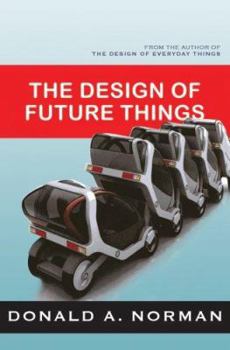The Design of Future Things
Select Format
Select Condition 
Book Overview
Donald A. Norman, a popular design consultant to car manufacturers, computer companies, and other industrial and design outfits, has seen the future and is worried. In this long-awaited follow-up to... This description may be from another edition of this product.
Format:Hardcover
Language:English
ISBN:0465002277
ISBN13:9780465002276
Release Date:October 2007
Publisher:Basic Books (AZ)
Length:231 Pages
Weight:1.08 lbs.
Dimensions:0.8" x 6.6" x 9.5"
Customer Reviews
2 ratings
Augmenation, not automation
Published by Thriftbooks.com User , 16 years ago
As Donald Norman points out, design today is taught and practiced as an art form or craft, not a science with validated principles through experimentation. Working with this premise, "Design of Future Things" (an ambitious title to say the least) is the authors attempt to move us towards distilling some universal rules on human-machine interaction. For the most part, the book reads as a collection of essays - offering a fusion of discussions on industrial and "artificial intelligence" design patterns. Key takeaway: we need augmentation, not automation; machines should act deterministically, without introducing uncertainty. Why four stars? Donald Norman skips over the non-physical world on which we all have come to rely: the internet, and how it is transforming everything around us. Virtually everything in our lives is now tethered to the online word, and it is only going to become more influential. Having said that, still a highly recommended read, along with Donald Norman's previous best sellers: "Design of Everyday Things", and "Emotional Design."
How intelligence will be installed in new devices
Published by Thriftbooks.com User , 16 years ago
This book was very interesting, as all of Don Norman's books are. In this book he goes into detail about how future designers will need to design future devices, how they can make them more useful and more human. He talks a lot about how what sounds like seemingly 'no-brainer' new features (radar-based minimum distance following cruise control) can actually cause problems (speeding up when you pull off the road, slowing down when you merge into traffic.) He gives suggestions to designers on how to avoid these types of issues and how to design things that are truly useful for humans. I thought it was a fascinating book and I learned a lot about design from it. He goes over the problems that making things too smart can cause and notes that when designing new devices the human interaction is the critical problem. A lot of future design will have to take into account how best to control human reactions in addition to providing the best features. Our devices are sometimes too smart (but not smart enough) and need to be designed to help humans in different ways than is first obvious. A fascinating description of what can go wrong and how to design around it using a system view.






